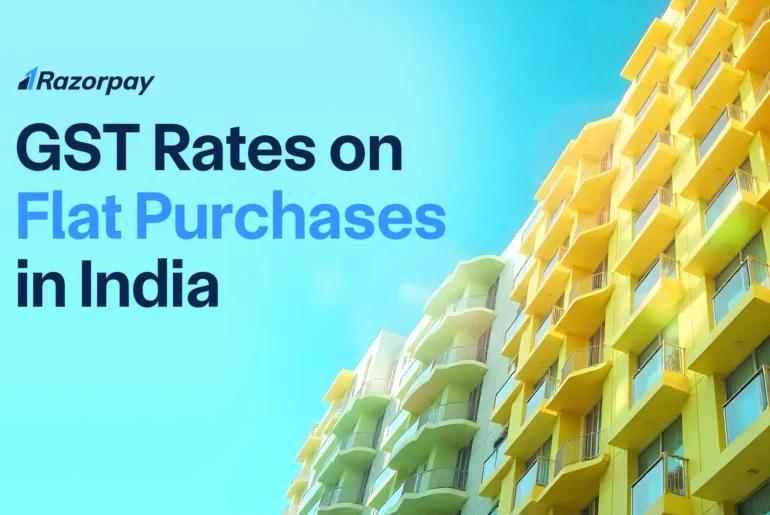Since the implementation of GST, the real estate industry in India has transformed, focusing on simplifying taxation. GST helps reduce the tax burden and increase transparency in property deals. This guide delves into GST on flat purchases in 2025, addressing under-construction flats, ready properties, affordable housing rates, and the registration process.
Table of Contents
What is the GST on Property purchases in India?
| Property Type | GST Rate | Input Tax Credit (ITC) | Applicability |
| Under-construction residential | 5% | Not available | Applicable to standard residential units |
| Under-construction affordable housing | 1% | Not available | Applies to homes meeting affordable housing criteria |
| Commercial property (under-construction) | 12% | Available | Includes office spaces, shops, etc. |
| Ready-to-move-in or completed property | 0% | Not applicable | No GST; treated as sale of immovable property |
Introduced in 2017, the Goods and Services Tax (GST) simplified real estate taxation by replacing various levies such as VAT, service tax, and excise duty. This unified tax structure brought greater transparency to the sector and aimed to reduce the overall tax burden for both developers and homebuyers.
Related Read: GST Rates in India 2025
Current GST Rates on Property
| Property Type | Previous GST Rate | Current GST Rate | Input Tax Credit (ITC) |
| Affordable Housing | 8% | 1% | Not available |
| Non-Affordable / Luxury Housing | 12% | 5% | Not available |
These revised rates, effective from April 1, 2019 were introduced by the GST council to promote affordable housing
Key Impact of GST on Property Transactions
The GST structure reduces tax complexity, especially for buyers, though developers may face increased costs due to the removal of ITC on luxury projects. This streamlined tax system supports more affordable property ownership and aims to make the real estate market more transparent.
Pre-GST Vs. Post GST – What Has Changed?
Before GST was introduced on July 1, 2017, the Indian real estate sector faced a heavy tax load because of various levies like VAT, service tax, and stamp duty. These multiple taxes resulted in a cascading effect, raising the overall property cost. Buyers were required to pay these taxes individually, complicating the process and driving up costs.
With the implementation of GST, the tax system became more streamlined, offering a unified tax rate and simplifying the entire process.
Related Read:
GST on Stamp Duty
GST on Brokerage Charges: A Beginner’s Guide
GST on Flat Purchase in 2025
1. GST on Under-Construction Flats
Typically, under-construction properties are taxed at 5% under the GST framework, though rates can differ based on the project type and location. Developers can claim an input tax credit (ITC) on materials and services used during construction; however, passing on this benefit to buyers isn’t mandatory. Buyers should clarify with developers about any ITC benefits offered, as it can affect the final cost of the property.
2. GST on New Flats
- The GST rate for new apartments under construction is set at 5%. The final cost of a new apartment can vary based on whether the developer passes the Input Tax Credit (ITC) benefit to the buyer.
- Developers can claim ITC on materials and labor used in construction, but passing this benefit to buyers is not mandatory.
Related Read: GST on Rent in India 2025
3. GST Rates for Flats Below ₹45 Lakhs
For flats priced below ₹45 lakhs, the GST rate is set at a reduced 1% without input tax credit (ITC), aimed at supporting the affordable housing sector and the government’s “Housing for All” initiative. This concessional rate applies to under-construction properties that meet specific size and price criteria for affordable housing.
| Criteria | Metro Cities | Non-Metro Cities |
| Carpet Area Limit | Up to 60 sq. m. | Up to 90 sq. m. |
| Maximum Price | ₹45 lakhs | ₹45 lakhs |
| GST Rate | 1% (without input tax credit – ITC) | 1% (without input tax credit – ITC) |
| Property Type | Under-construction affordable housing | Under-construction affordable housing |
These conditions are intended to make housing more accessible, especially in growing urban areas, and promote development within the affordable housing segment.
4. GST on Flat Purchase Above ₹50 Lakhs
| Criteria | Details |
| Applicable Property Type | Under-construction properties |
| Price Range | Above ₹50 lakhs (exceeds ₹45 lakhs limit) |
| GST Rate | 5% |
| Input Tax Credit (ITC) | Not available |
| GST on Completed/Ready-to-Move-in Property | Not applicable |
5. GST on Ready-to-Move Flats
- GST does not apply to ready-to-move properties with a valid occupancy certificate, as they are classified as completed goods, not services.
- If a flat lacks a completion certificate or has ongoing interior work, it could still be considered under construction and subject to GST.
6. GST on Registration of a Flat in India
- GST on property purchase is not levied on the registration of completed flats in India. Properties with a valid Completion Certificate are exempt from GST.
- A Completion Certificate is a legal document issued by the local municipal or development authorities. It certifies that a building (flat or property) has been constructed as per the approved building plan and complies with local laws and regulations.
Affordable Housing GST Rate in 2025
For affordable homes priced at ₹45 lakhs or less, the GST rate in 2025 is 1% without the option to claim ITC.
**Disclaimer: The GST rates mentioned above are subject to change as per government policies and regulations. These rates may differ depending on the property type, location, and other factors. It is recommended to consult with a tax professional or the relevant authorities for the most up-to-date information before making any property purchase.
GST on Maintenance Fees for Housing Societies
| Criteria | Details |
| Annual Turnover of Housing Society | Above ₹20 lakh |
| Monthly Maintenance Fee per Unit | Above ₹7,500 |
| GST Rate | 18% |
| GST Applicability on Monthly Fee | Full amount (e.g., ₹9,000 – GST applicable on ₹9,000) |
| Housing Societies with Turnover Below ₹20 lakh | Not liable to pay GST |
Housing societies with turnover below ₹20 lakh are not liable to pay GST, and charges like water and property taxes are exempt
Related Read: GST on Maintenance Charges
GST on Developable Land
1. No GST on Developable Land
According to a CBIC circular dated August 3, 2022, GST is not applicable on the sale of developable plots, even if basic infrastructure is in place. This exemption has also been upheld in Karnataka through a recent Authority of Advance Ruling (AAR) decision.
2. Differing Interpretations in Past Rulings
Some states previously took a different stance on GST for developed plots. For instance, the Madhya Pradesh Appellate Authority of Advance Ruling (AAAR) ruled in July 2022 that an 18% GST would apply to land sales with infrastructure developments. Similar interpretations were seen in a 2021 ruling by the Gujarat Authority of Advance Ruling.
3. Comparison with Stamp Duty and Registration Fees
Before GST, sales of immovable properties were exempt from VAT, with only stamp duty and registration fees imposed by state governments. These fees still apply in addition to GST on under-construction properties, and they vary between and within states.
Input Tax Credit (ITC) on Property Purchase in India
1. ITC under GST enables businesses to offset the taxes they pay on purchases by deducting the GST already paid on inputs, thereby preventing the cascading of taxes and lowering costs.
2. The GST paid on construction inputs is eligible for ITC for property purchases. However, this benefit does not extend to residential properties for personal use and is primarily for commercial or rental properties.
3. If a developer purchases construction materials worth ₹15,00,000 with an 18% GST (₹2,70,000), they can claim an ITC of ₹2,70,000, reducing the GST liability when selling the property.
Related Read: What are the Cases Where ITC Is Not Applicable?
Example Calculation of GST on Flat Purchase in India
To calculate the GST on a property purchase, you need to follow these steps:
STEP 1: Start by identifying the base price of the flat, excluding any additional fees or related costs.
STEP 2: Check the applicable GST rate for the property type
Respective GST Rates:
- For non-affordable housing, apply a 5% GST rate.
- For affordable housing, apply a 1% GST rate.
STEP 3: Calculate the GST amount by multiplying the base price by the applicable GST rate.
STEP 4: Add the calculated GST amount to the base price to determine the total purchase cost of the flat.
Example:
If the base price of an affordable housing flat is ₹40,00,000, the GST would be calculated as follows:
GST = ₹40,00,000 * 1% = ₹40,000.
Thus, the total cost of the flat would be ₹40,00,000 + ₹40,000 = ₹40,40,000.
Related Read: How to Pay GST on the GST Portal Online?
Impact of GST Rates on Flat Buyers
Here’s a breakdown of how GST affects flat buyers:
1. GST on Under-Construction Flats
GST is applicable on under-construction flats at 1% for affordable housing and 5% for non-affordable properties. This should be considered when budgeting for the property
2. No GST on Ready-to-Move-In Flats
Ready-to-move-in flats with an occupancy certificate are exempt from GST, making them more cost-effective compared to under-construction properties
3. GST Exemption on Land Purchases
GST does not apply when buying land for construction, making it an attractive option for those looking to build a home
4. Input Tax Credit (ITC)
Developers may pass on ITC benefits to buyers, reducing the overall GST cost. However, this is optional, so it’s important to check with the developer
Note: Check for GST Updates. GST rates can change, so it’s essential to stay updated and consult a professional before purchasing property.
GST on Government Housing Schemes
1% GST: Under key government initiatives like the Pradhan Mantri Awas Yojana (PMAY) and Rajiv Awas Yojana, the GST rate is reduced to just 1% for affordable housing. This move helps lower the financial burden on homebuyers from economically weaker sections and lower-income groups.
With such low GST rates, the government aims to make home ownership more accessible and affordable for all.
Frequently Asked Questions
1. Is there a concessional GST rate for affordable housing projects?
Yes, affordable housing projects under schemes like Pradhan Mantri Awas Yojana are eligible for a concessional GST rate of 1% without input tax credit, effective April 1, 2019.
2. How does GST impact home loan EMIs for flat purchases?
While GST doesn’t directly impact home loan EMIs, it does affect costs such as processing fees and legal charges, which could marginally increase the EMI.
3. What is the GST rate on luxury housing projects?
Luxury housing projects are subject to a 5% GST rate without ITC, increasing the overall cost for buyers.
4. Are there any government incentives related to GST for first-time home buyers?
First-time home buyers can benefit from the Pradhan Mantri Awas Yojana (PMAY), which offers subsidies on both home loans and interest rates, reducing the cost of homeownership.
5. Is there GST on flats above 45 lakhs?
Yes, under-construction flats priced above ₹45 lakhs attract 5% GST without input tax credit (ITC).
6. How do I avoid GST on a flat purchase?
You can avoid GST by purchasing a ready-to-move-in or completed flat, as GST is not applicable to such properties.
7. Can a builder charge 12% GST?
No, for residential properties, the applicable GST is 5% without ITC. Builders cannot charge 12% on residential flats.
8. What is 12% GST on property?
The 12% GST rate applies to under-construction commercial properties where input tax credit is allowed. It does not apply to residential units.


